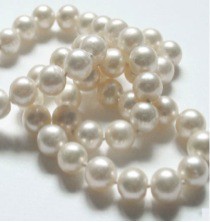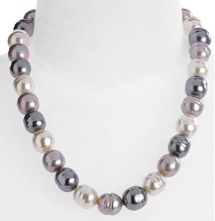 Loading... Please wait...
Loading... Please wait...Categories
7 Ways to Tell If Your Pearls Are Real Or Fake
Posted by Bess Heitner on 21st Feb 2024
Can you tell if your pearls were made in an oyster or in a factory? And why does it matter?
Genuine pearls are an investment that can last forever. They are the only “gems” made by a living creature in fresh water or saltwater. They may be natural (very rare) or cultured, which means they are made at an oyster farm by inserting a small piece of shell into an oyster or mussel that secretes a silky coating known as the “nacre” around the irritant — layer by layer — until a pearl is formed. Fake pearls, on the other hand, are made by machine out of glass or other synthetic materials covered with coats of pearl “essence” and polished. Some can look gorgeous to the naked eye like the popular and expensive “Majorica” brand but in the end they are still costume jewelry.
Question: Which of the pearls below is fake?


(answer below)
- The Luster Test. The most critical factor in judging a pearl is the bright surface shine and three-dimensional reflective glow known as luster. The thicker the nacre, the higher the luster. Imitation pearls may look fantastically shiny on every part of the surface but in natural light, they won’t reflect luminosity like real pearls. They have the same overall tone which becomes dull over time.
- The Symmetry Test –Pearls come in many shapes from round to oval to baroque. But even the most prized Mikimoto matching “round” pearls that take years to assemble are not absolutely identical because each pearl is made by a living organism not a machine. Genuine pearls can have concentric ridges, circles or little flaws, which inexperienced people may think is fake. But, in fact, fake pearls are too perfect. If every pearl is exactly the same shape and size, it is not real.
- The Size Test– Diamonds and gems are measured in karats. Pearls are measured in millimeters. Except for rare museum specimens, real pearls are usually nor more than 14mm. If you see huge perfectly matched pearls, they are certainly fakes.
- The Tooth Test – Real pearls are never perfectly smooth because they are made up of layers of nacre that are deposited like sand on a beach. If you lightly rub it against the front or tip of your tooth, it will feel slightly gritty or bumpy. If they are absolutely smooth, they are not real.
- The Friction Test – If you can’t try the tooth test, rub two pearls together . If they feel gritty or sandy, they are real. If they are totally smooth, they are not.
- The Weight Test – Real pearls are heavier than faux pearls
- The Temperature Test – Real pearls are cool to the touch and warm up as you wear them. Faux pearls will stay the same room temperature at all time
- Don't Judge a Pearl by its Shape - The rounder the pearl the more likely it is to be fake since they are so rare they would cost a fortune - Now baroque, biwa, and tons of shapes are becoming more popular than your grandmother's perfect pearls - but that's a story for another blog.
Answer: Both pictures above are very good fakes.
If you look closely at the white pearls at the left they are all uniformly round, smooth, and shiny even though they are knotted to look like real pearls. The“baroque” pearls on the right are different colors but uniform in size and shape with intentional “ridges” in the same place. They are from Majorica.
Compare them with these real pearls on my website that pass each of the tests above.
Finally, since pearls are most people's favorite (certainly mine) here's a few tips on how to care for them.
If you want your pearls to look as good and last as long as possible, apply your makeup, perfume and anything else first. Pearls should go on last. After wearing, it helps to rub the jewelery with a damp, soft cloth to remove any last traces of cosmetics. Pearls should be stored separately from other jewelery. This avoids possible scratches on the delicate surface. If possible, pearls should be stored in padded boxes or in soft cloths.And NEVER hang any jewelry but especially pearls. They should be stored flat and usually require restringing every few years at the least.
